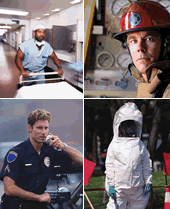EMERGENCY RESPONSE RESOURCES

Personal Protective Equipment
Personal protective equipment is very important for any emergency responder. There are five main types of PPE that are covered on this page: respirators and protective clothing (selection, proper use, etc.), skin exposures and eye and hearing protection.
Respirators
Respirator User Notice Issued November 27, 2013: Chemical Warfare Agent (CWA) Testing for NIOSH CBRN Respirator Approvals
Guidance on Emergency Responder Personal Protective Equipment (PPE) for Response to CBRN Terrorism Incidents
This document provides comparison information on the OSHA/EPA Protection Levels A, B, and C to DHS adopted Personal Protective Equipment (PPE) performance based standards for response to terrorism incidents involving Chemical, Biological, Radiological, and Nuclear (CBRN) hazards.
Protecting Emergency Responders, Volume 4: Personal Protective Equipment Guidelines for Structural Collapse Events
This guidance focuses on three issues that present unique challenges in the response to a multistory-building collapse: (1) protection from biological hazards; (2) protection from inhalation of hazardous materials; and (3) required modifications to responders' typical PPE ensembles because of the duration and intensity of the response. Other documents in this NIOSH/Rand series.
What You Should Know in Deciding Whether to Buy Escape Hoods, Gas Masks, or Other Respirators for Preparedness at Home and Work
Information for any employer or consumer considering purchasing escape hoods or other respirators to protect themselves against potential terrorist threats, including biological and chemical substances. This guidance provides information on what respirators are, how they work, and what is needed for a respirator to provide protection.
NIOSH Respirator Topic Page
This page provides information on basic respirator protection as well as types of respirators, user notices, respirator selection, respirator certification process, standards and rulemaking.
NIOSH Respirator Selection Logic 2004
DHHS (NIOSH) Pub. No. 2005-100
Provides a process that respirator program administrators can use to select appropriate respirators to protect workers in specific workplaces. Replaces the NIOSH Respirator Decision Logic (NIOSH Publication No. 87-108), and includes information on N-95 through P-100 particulate respirators.
Certified Equipment List
This searchable database contains all certified respirators. Users can search on type of respirator, protection, manufacturer, facepiece type, etc. to find out the equipment that has been approved by NIOSH that meet the search criteria.
OSHA / NIOSH Personal Protective Equipment Selection Matrix for Emergency Responders
Identifies areas where chemical contamination is likely or less likely using a zone matrix (red, yellow, and green). Also lists specific risks and guidance on selecting PPE in each zone.
OSHA/NIOSH Interim Guidance: CBRN Personal Protective Equipment Selection Matrix for Emergency Responders - Radiological Dispersal Device
Provides technical assistance to employers in an emergency response event related to a Radiological Dispersal Device (RDD), or "Dirty Bomb".
OSHA/NIOSH Interim Guidance - CBRN Personal Protective Equipment Selection Matrix for Emergency Responders- Nerve Agents
Provides technical assistance to employers in an emergency response event related to exposure to nerve agents.
OSHA/NIOSH Interim Guidance - CBRN Personal Protective Equipment Selection Matrix for Emergency Responders - Blister Agents
Provides technical assistance to employers in an emergency response event related to exposure to blister agents
Suggested Respirator Cleaning and Sanitation Procedures
Guidance for selecting cleaning equipment and supplies, procedures for respirator maintenance.
Protective Clothing
NIOSH Protective Clothing Topic Page
Provides guidance on selection of chemical protective clothing and other information resources from NIOSH's Protective Clothing and Ensembles program. This program incorporates a broad range of studies of how chemicals seep through barrier materials, leak through small holes, or change the barrier material to reduce its protection.
Recommendations for the Selection and Use of Respirators and Protective Clothing for Protection Against Biological Agents
NIOSH Publication Number 2009-132
This document is based on current understanding of the potential agents and existing recommendations for biological aerosols and is oriented toward acts of terrorism.
NIOSH Interim Guidance on Personal Protective Equipment and Clothing for Flood Response Workers
Provides information on hazards to flood cleanup workers and guidance for selecting clothing and protective equipment.
En Español
NIOSH Pocket Guide to Chemical Hazards
Exposure limits, Respirator Recommendations, First Aid, more... The Pocket Guide is a source of general industrial hygiene information on several hundred chemicals/classes found in the work environment. Key data provided for each chemical/substance includes name (including synonyms/trade names), structure/formula, CAS/RTECS Numbers, DOT ID, conversion factors, exposure limits, IDLH, chemical and physical properties, measurement methods, personal protection, respirator recommendations, symptoms, and first aid.
Skin Exposures
NIOSH Skin Exposures and Effects Topic Page
Information related to NIOSH skin research as well as a link to the NIOSH skin permeation calculator, a resource that allows users to input data and measure the conductance of skin to a particular chemical from a particular vehicle.
Eye Protection
NIOSH Eye Safety Topic Page
Contains general information on preventing eye injuries as well as NIOSH eye safety resources, occupational eye injury statistics, and eye related NIOSH Health Hazard Evaluations and Fatality Reports
Eye Safety - Emergency Response & Disaster Recovery
This NIOSH web page provides an overview of eye hazards and injuries, types of eye protection, safety for prescription lens wearers, first aid, etc.
En Español
Eye Protection for Infection Control
This NIOSH web page provides background information and specific details on eye protection that can be used to supplement eye protection recommendations provided in current CDC infection control guidance documents. It is intended to familiarize workers with the various types of eye protection available, their characteristics, and their applicable use.
Hearing Protection
NIOSH Noise and Hearing Loss Protection Topic Page
Page provides information on choosing a hearing aid that is right for you, access to the NIOSH Noise Meter, hearing conservation check list and toolbox (for hearing conservation professionals)
- Page last reviewed: August 12, 2013
- Page last updated: December 2, 2016
- Content source:
- National Institute for Occupational Safety and Health Office of the Director


 ShareCompartir
ShareCompartir